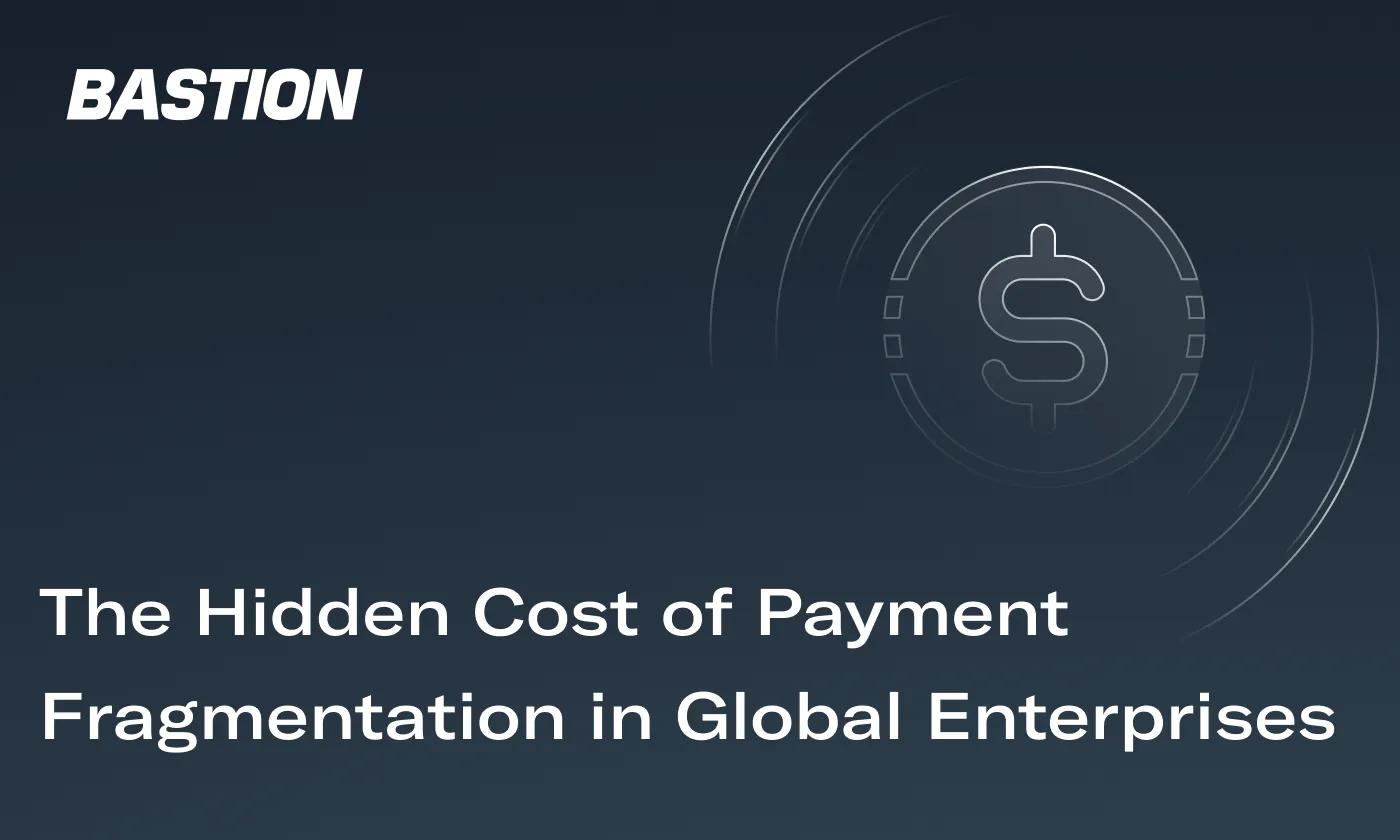
As financial systems have grown more complex without matching automation, enterprises face rising human and operational costs from payment fragmentation. Treasury teams now often spend more time managing disconnected systems than optimizing liquidity.
Fragmentation occurs when payment processes (sending, receiving, and reconciling) remain disconnected. This forces enterprises to juggle multiple banking relationships, each with its own log-ins, cut-off times, and settlement schedules. The result: wasted time, bottlenecks, and productivity loss. Payments routed through two or three banks add “multi-hop” complexity with each hop introducing fees or delays.
Instead of focusing on strategy, treasury staff are often pulled into daily administrative tasks such as rebalancing accounts, reconciling statements, and tracking down account transfers, especially when managing dozens of bank accounts across countries. Payment rails that batch transactions closing at different cut-off times lead to batching inefficiencies, and dramatic time differences across jurisdictions cause settlement speed variations and trigger coordination nightmares.
Overall, treasury decision-making delays, although unavoidable with legacy systems, slow business execution and reduce responsiveness. This reactive state limits strategic capital allocation and puts enterprises’ balance sheets at a disadvantage with peers with automated systems.
Operational Bottlenecks and the Productivity Tax
Global enterprises face significant hidden costs from maintaining dozens of disconnected banking relationships across jurisdictions. While some expenses are more visible, such as wire transfer fees and FX spreads, others are embedded in structural inefficiencies.
A 2025 study by Oxford and FIS Global estimates that large enterprises lose an average of $98.5 million annually due to a combination of factors, including cyber threats, fraud, and friction in payment processing among others.
These costs illustrate how payment fragmentation not only erodes efficiency but also compounds broader risks that weaken enterprise financial performance.
How Payment Fragmentation Develops in Multi-Subsidiary Corporations
Large enterprises expand by entering new markets, incorporating subsidiaries, and launching new products. Each new entity often requires additional banking relationships, especially where regional banks lack global payment capabilities. As these relationships multiply, so do operational inefficiencies. Treasury becomes a bottleneck as manual approvals slow processes while accounting faces longer reconciliation cycles at month’s end. Onboarding new banking partners can involve dozens of stakeholder sign-offs and extensive due-diligence paperwork, consuming scarce treasury, accounting, and compliance resources.
Fragmentation further erodes liquidity. Traditional cross-border payments still settle on T+1 to T+3 timelines, depending upon corridors and banking cut-offs. With working capital tied up in transit, treasury teams lose yield opportunities and face reduced flexibility.
Data fragmentation adds another layer of complexity. Multiple banking partners produce transaction data in different formats, making treasury teams manually standardize inputs before reconciling balances at scale. During this lag, cash sits idle while enterprises wait for settlement. Each additional banking relationship introduces distinct compliance requirements and approval processes, multiplying overhead and diverting resources from higher-value activities.
Time for Transformative Financial Solutions: Unified Payment Infrastructure
A unified payment infrastructure centralizes payment channels into a single platform, integrating bank transfers, credit cards, digital wallets, and other payment methods. By consolidating these processes into a blockchain-based interface, enterprises can eliminate much of the complexity and redundancy created by fragmented systems.
Cross-border payments provide a clear use case. In 2024, the International Monetary Fund reported that global cross-border payments nearly reached $1 quadrillion ($1,000 trillion) with fee structures varying significantly across jurisdictions.
According to World Bank data cited by Grand View Research, the average cost of sending money remained high in 2023: 6.2–6.3% into the United States, 6–7% into South Asia, and more than 7% into Africa. These levels stand in sharp contrast to the World Bank’s sustainable development goal of reducing costs to 3%.
Potential efficiency gains are substantial. In April 2025, the Deloitte Center for Financial Services estimated that a unified payment system could reduce costs by 12.5% by 2030, representing savings of more than $50 billion.
They also projected that, by 2030, one-quarter of large-value international transfers will move through blockchain token platforms. Stablecoins, in particular, are viewed as offering a pathway for wholesale cross-border payments, combining speed, cost-efficiency, and reduced settlement risk,
Real-World Evidence: Solving Industry Pain Points
These real-world use cases highlight the pathway for next generation enterprise and institutional solutions like Bastion.
Bank Use Case: JPMorgan
In 2020, the largest bank in the United States introduced Kinexys to expand blockchain-based settlements and enhance wholesale payment capabilities. Kinexys securely enables reduced friction with near-instant payments around the globe at a fraction of a penny, boosting enterprise liquidity.
Kinexys benefits both JPM’s internal transactions and those of their institutional clients as billions of dollars smoothly go through interbank and cross-border transfers with reduced counterparty risks. The blockchain’s distributed ledger technology ensures tamper-proof, traceable transactions, reducing fraud.
Payment Processor Use Case: Stripe
In May 2025, Stripe announced that merchants could now hold assets and pay vendors globally in more than one hundred countries using two stablecoins: Circle’s USDC and Stripe’s native USDB. They launched stablecoin-funded accounts to facilitate cross-border transactions with balances supported in U.S. dollars, British pounds, and euros. Stripe’s new AI tool will allow developers to incorporate code that enables programmed purchases desired by users, collaborating with Visa to offer the choice of AI-enabled payments.
Merchants can accept USDC payments, without needing to hold or convert fiat, on the following blockchains: Ethereum, Solana, Polygon, and Base; fees are based in USD at a rate of 1.5% of the transaction amount.
B2C Use Case: SpaceX
When customers in financially underdeveloped countries pay for their Starlink telecommunication services, SpaceX converts that local currency into stablecoins. This streamlines transactions from a range of currencies, mitigates FX risk, and eliminates the need to wire these funds.
Gig Economy Pay Use Case: Scale AI
Overseas contractors can choose to receive their pay in stablecoins, which simplifies complexities that can occur with cross-border pay compensation. This provides timely, stable payments for the contractors despite any volatility in local currencies.
Unified Payment Infrastructure as a Modern Solution
A unified payment infrastructure addresses the inefficiencies of correspondent banking by enabling direct, programmable settlement, 24/7. Treasury can establish automated, dynamic thresholds to sweep idle balances into tokenized money market funds, generating yield while maintaining strict controls.
Each transaction produces a unified, real-time data record, giving treasury teams full visibility across global operations. This transparency replaces manual forecasting with automated, data-driven reporting, improving both accuracy and timeliness.
Operational efficiency improves dramatically. As one example, settlement times that once stretched from one to three days in Latin American corridors are processed in minutes. This transformation allows treasury to shift from a cost center into a strategic enabler of enterprise growth.
By adopting a unified infrastructure across markets and currencies, enterprises can scale globally without the traditional complexity of managing multiple local bank accounts and FX hedging. At the same time, they preserve regulatory compliance while achieving greater speed, liquidity, and control.
How to Prepare for Unified Payment Infrastructure Implementation
Here is the three-step transformation.
Internal: This stage integrates intercompany transfers onto unified rails and enables near real-time cash positioning across subsidiaries while also automating routine treasury operations and approval workflows.
External: Enterprises transition high-volume cross-border payments to faster settlement rails, integrating these processes with existing ERP and treasury management systems. This allows payment flows to scale efficiently across both vendors and customers.
Advanced Financial Operations: Enterprises can deploy programmable payment logic and automation; optimize yield across global cash positions; and build ecosystem monetization capabilities.
Detonate Payment Fragmentation Costs and Strategic Limitations
Together, these phases move treasury from fragmented, reactive operations toward a unified, strategic role in enterprise value creation. Providers such as Bastion are bringing these capabilities into production for enterprises seeking measurable, compliant efficiency gains.
